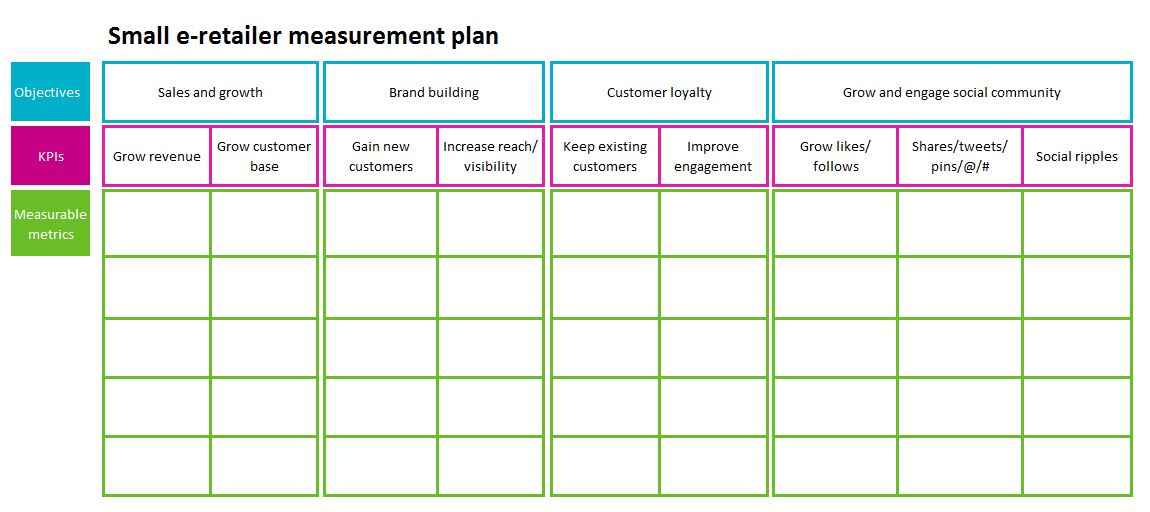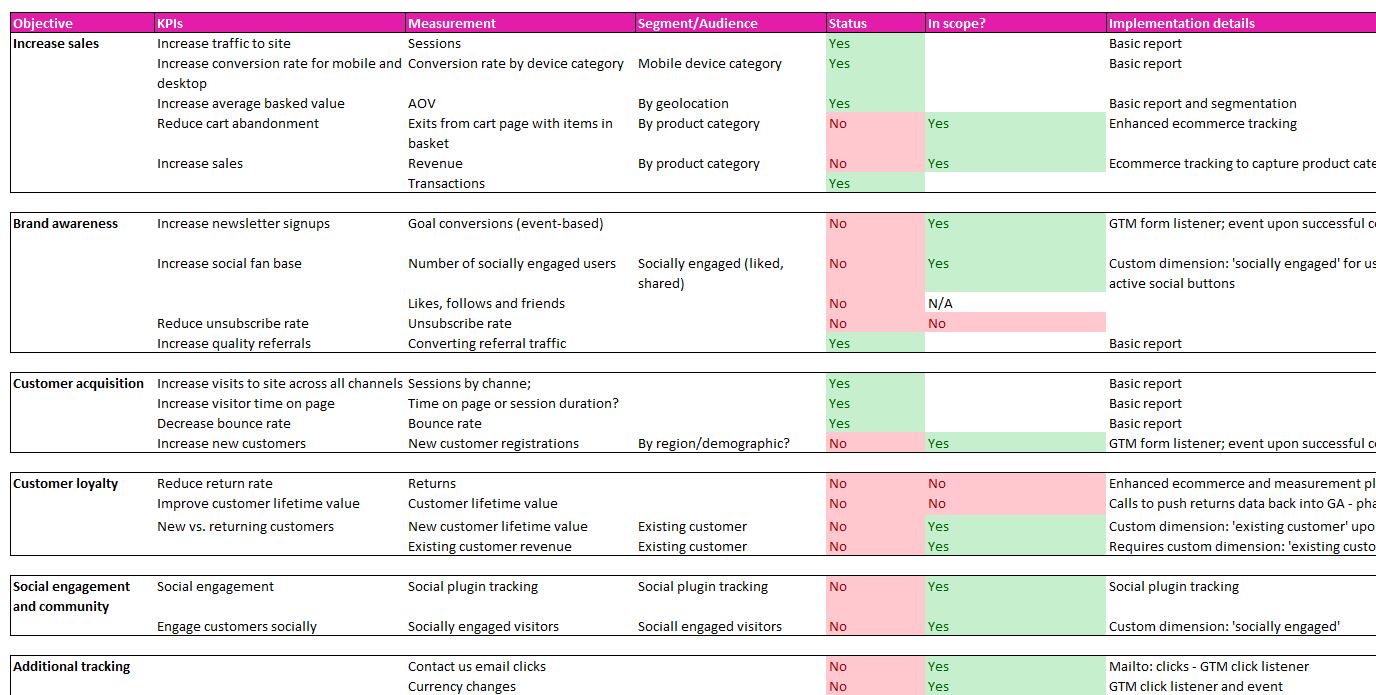How to Create a Measurement Plan and Why You Really Need One (2025 Update)

By Julian Erbsloeh|26 Jun 2025
A measurement plan is a document that translates your top-line business objectives into dimensions, parameters, and metrics you can measure on your website. It provides a robust framework for customised web analytics configuration and forms a vital part of your broader digital marketing strategy.
The plan helps you understand how your digital channels work together most effectively to achieve your KPIs.
Download our free measurement plan template and guide
Common Sense Planning Starts With a Question (or Two)
For us, this sounds like common sense, but you'd be surprised how the analytics and data team is still met with silence and confused looks when asking simple questions such as:
- What do you need your website to do for your business?
- What are the critical conversion points you need to measure?
Creating a robust measurement framework is a core element of an advanced configuration of Google Analytics 4 (GA4), usually preceded by an audit of the current setup. Without exception, every online business needs to have a measurement plan.
Many great blogs exist on the subject (Avinash Kaushik's post is an old goodie worth reading). Google also provides many good resources on the topic, for example, in the Google Skillshop, where you can find a host of learning resources and even professionally recognised certifications.
However, we've found that good resources can be quite technical and challenging to follow for non-analysts. That's why we've decided to share our process and a free downloadable measurement and implementation plan for you to use for your website.
"With the explosion of AI tools in 2025, the structure of your data model has never been more important, so we have added a section on creating a robust data model to the revised version of this popular blog post. Data quality is critical when you plan to feed that data into an AI model, so you need to put the effort into meticulous planning and documentation of your data so that AI can do some of the other hard work for you."

Julian Erbsloeh, Head of Data and Insight
So, What Do You Need to Create Your Own Measurement Plan?
The first thing to consider is who needs to be involved. The complexity and implementation of your measurement framework depend on your organisation's size, as does the number of people involved in the exercise.
With that in mind, ensure that one of the team members has the following skills to create the plan:
- Someone who understands your business objectives and strategy
- Someone who understands web analytics and what it can do
- Someone technical who can set up your custom tracking configuration
A data engineer or data scientist who may work with the raw data outputs of whatever you collect, planning to feed them into LLMs or AI tools of some description
This process means bringing different stakeholders together for large organisations (which can be challenging). Importantly, obtaining buy-in from C-suite executives at this stage provides the project with the attention it deserves and the motivation to complete the exercise.
Step 1 – Define Your Objectives and Key Performance Indicators (KPIs)
Create a simple document (MS Excel or Google Sheets works well for this) and outline the top-line business objectives for your website horizontally across the top:

Identify strategies and tactics to support the achievement of those objectives and define the KPIs for each; remember, some goals will have multiple KPIs.
Example: If the objective is revenue, key strategies to drive revenue could be increasing sales, increasing average order value, and reducing returns, which in turn form the KPIs.
Once the list of KPIs is complete, you need to define the data points that support each one. To achieve the objective of brand building and the relevant KPI of 'gain new customers', suitable data points include total sessions, new users, first-time purchases, and new customer registrations.
Once your plan is complete, seek approval from key stakeholders and, ideally, the Board. It is worth noting that this list is never definitive and will need periodic review to ensure it remains up-to-date and in line with the ever-changing digital environment.
Step 2 – Consider Data Segmentation and Data Engineering Requirements
With the basic measurement framework in place, it is time to consider segmentation and data engineering requirements.
- Should you be able to analyse your data by more than device category?
- How do we capture and report on membership tiers or different levels of subscriptions to our services?
- How do we want to report on product category and sub-category performance by seasonality, and how do we know whether a user bought an item during the sale (or not)?
- What data points will we need to create audiences of high-net-worth individuals, cart abandoners, loyal customers, or those with a high propensity to churn?
These questions need to be addressed at this stage, as most advanced segmentation will require custom parameters when creating the data model for your web analytics platform (let's assume it's GA4). Your data engineering team (or agency/contractor) should also review your proposed data model to ensure that it does not create unforeseen issues later.
For example, custom events, parameters, metrics, and dimensions must be set up. This is also when you need to start thinking about your different audiences.
At this stage, the measurement plan should outline the detailed translation of business objectives into measurable performance metrics.
Not all the metrics you have picked can be measured using Google Analytics (GA) or your analytics platform of choice. Social metrics, such as likes, retweets, and repins, are good examples of metrics in most measurement plans that a GA implementation cannot deliver on. Highlight these metrics in your plan for later consideration.
With all the primary metrics in place, you can begin to set targets for each metric. If you don't already have something in mind, the wider team and key stakeholders may get involved again.
Step 3 - Create an Implementation Plan
Now that you know what you want to measure and track, you need to implement all the tracking. An audit of the existing GA4 configuration will identify gaps and indicate any additional tracking required.
For analytics tools like GA4, you need to start thinking about the data model. The data model is the structure of event names, parameters, values, and other elements that form the dataset with which you will be working as an analyst. Getting this right from the beginning is so important that we recently published a separate blog post on the subject of creating a robust data model. Follow this link to also find an up-to-date template of our solution design document (aka event map).
Next question – implementation method!
If you aren't already using a tag management solution like Google Tag Manager, this is the right time to reconsider. Implementing your tracking code using a tag container instead of adding it directly to the website code means you will be more agile in the future when changes are needed. This is especially true when additional tags are required or the tracking needs to be modified due to changes on your website.
Using a tag container reduces the risk of missing a tag during migration. If, for example, your website is likely to change or migrate, it is more manageable for your developers to transfer a Google Tag Manager snippet, along with any dataLayer information, than to locate various third-party tags individually.
Google Tag Manager is a free tag container solution that covers all the tagging requirements for most online businesses. Find out more about how the solution works in our recent blog post, "A guide to getting started with Google Tag Manager."
Once you know what tracking is in place and decide how you want to implement your tracking code, it's time to devise an implementation plan. You can use another tab in the same Excel document, utilising columns to highlight what is in scope, already in place or any required additions.

While we often skip this stage of the project these days, proceeding directly to solution design provides a good working document for implementation. It makes it easy to assign individual tasks to specific people, keep shared checklists of all required steps, and communicate across teams and departments if needed. You can utilise a preferred project management solution to manage the process.
After considering all technical aspects and agreement on the tracking solutions for the KPIs, it will be time to implement the new, advanced tracking.
It is unlikely that everything will work as expected from the word 'go'. We always set up a test web property in GA to verify the data and ensure everything is tracking accurately before sending the 'new' data to the existing reporting property. This task is best practice and is essential to avoid collecting inaccurate data throughout the transition period.
The final step of the measurement planning cycle is to plan for ongoing maintenance and refinement of the plan as time goes on. Your technical requirements, business, and the digital landscape can and will change over time, so it is essential to periodically review the measurement plan and adjust it accordingly to ensure reports remain accurate.
💡 Pro Tip:
Remember to set up GA4 Intelligence alerts to inform you immediately of unusual peaks and drops in your data.
Step 4 - Define the Format and Frequency for Reporting
This next step is not part of creating the measurement plan itself, but the logical extension – agreeing on the reporting format and frequency.
In some cases, which usually apply to smaller businesses and websites, all KPIs can be tracked and reported using the standard reports in GA4. Gathering all the key numbers can be simplified by creating an Explore report and sending automated emails to all stakeholders on a weekly basis, typically every Monday.
However, many businesses we work with have more specific reporting requirements for their monthly or weekly BAU reporting. We offer a variety of reporting and custom performance dashboarding solutions that help our clients in various ways. We build reporting dashboards in Looker Studio and Power BI, and we almost exclusively extract raw GA4 data to BigQuery, allowing us to be much more flexible in blending it with other data sources. The accuracy and speed of reporting are also significantly improved when the data comes from BigQuery, as it eliminates the 'guesswork' of GA4's data modelling.
Even better, BigQuery also captures the anonymised data of users who did not consent to analytics cookies so that you can model their behaviour yourself.
We published a great blog post last year about the GA4 export schema and what you can do with the GA4 data.
Consider what information you need and how frequently you need it to stay on top of what's happening on your website.
Step 5 – Plan for Ongoing Maintenance and Refinement
The final step of the measurement planning cycle is to plan for ongoing maintenance and refinement of the plan as time goes on. Your technical requirements, business, and the digital landscape can and will change over time, so it is essential to periodically review the measurement plan and adjust it accordingly to ensure reports remain accurate.
Remember to also always update the solution design you have created. With GA4 configurations being more customised and complicated than ever, up-to-date documentation of what you have in place is critical.

Want to create your own measurement plan?
What Next?
If you need help creating and implementing a measurement plan, we can help. We offer various services related to digital analytics, data engineering, analysis, reporting, and business insights, which we would love to discuss with you.
Get in touch to learn more about how we can help you and your business extract valuable, actionable insight and get a step ahead of your competition.
Get Fresh Thinking and Stay Ahead of Digital Marketing Trends
Subscribe to our Fresh Thinking Newsletter and get...
✅ Exclusive invites to our helpful knowledge-share events✅ Curated news roundup of pertinent and topical industry news
✅ Early access to our industry resources and insights.
Register for Fresh Thinking and keep up to date with our helpful digital marketing news insights.